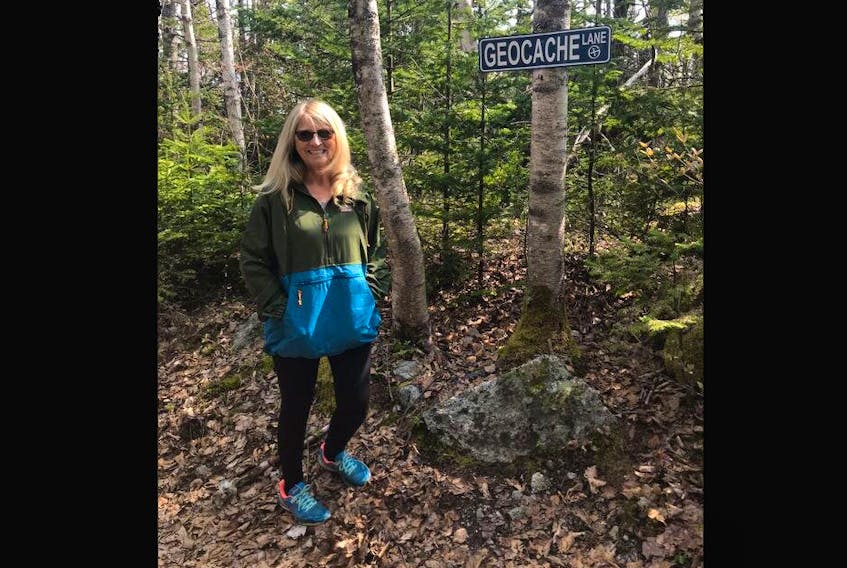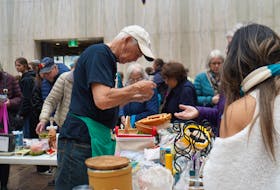She’s fallen into a few brooks and been bitten by ticks twice. But that hasn’t slowed Brenda Bulger down a bit.
The Charlottetown, P.E.I., woman was looking for a hobby to get into after retiring from the Prince Edward Island Public Service Commission in 2011. She wanted something inexpensive to get her outside and back to nature. After a bit of homework, she decided to take up geocaching. Her cacher name is “islanddunes.”
“I grew up in the forest land of northern New Brunswick, and I remember as a kid going out and hiding pennies in trees or certain places, under rocks and then the next summer going back and trying to find them,” says Bulger.
“Well, then it was based on your memory, you had no GPS or co-ordinates or anything to take you to the exact location.”
Bulger describes geocaching as where people, called geocachers, place a container in certain spots around the world. The container can be any size, from the tip of your finger to five gallon containers or even bigger, says Bulger.
“You go and you hunt for this container using your GPS, some people use their cell phones, but most use a GPS because it tends to be a bit more accurate, and you’re not using data. Most caches have a log sheet or a log book, where you record that you found it. Then when you go back home, or even on your GPS, you can log that you found it.”
In it for the hunt

Bulger says some geocachers are in it for the find; they want to be the first to get to the cache.
“I know some here on the island that have found around 48,000-50,000 caches. I certainly have not, to that extent. For me, I’m just sort of tinkering around with it,” she said.
Bulger says she tends to be more of what she calls a ‘lopsided cacher.’
“I enjoy the hiding of them as opposed to the finding of them,” she says.
There are over 7,000 caches planted across P.E.I., including about 1,800 along the Confederation Trail, which goes from one end of the island to the other.
“I haven’t found very many because I spend most of the time hiding them. I have 64 caches that I maintain, somewhere between 600 and 700 that I’ve found. I take a lot of time in finding out where I’m going to put my cache and take coordinates on two or three occasions, then finally place the cache and submit it for review,” she said.
Bulger has a variety of caches — including one in a flower bed in her front yard called ‘Prince Charming.’ Caches often have a hint that can be found on the geocache website, along with the cache coordinates, a description, and sometimes photos.
“For Prince Charming, my hint is, ‘She kissed her magic prince’ because I’m a marriage commissioner. My sign for that is kind of up above it. So here’s your Prince Charming.”
Three years before she retired, Bulger had decided she wanted to continue to do something afterwards on a part-time basis. She now also teaches the marriage commissioner course on the Island.
Bulger also has a cache downtown Charlottetown called ‘People watching with Johnny’, around a bronze statue of Sir John A. Macdonald.
“It’s right in the bar district of Charlottetown, so when you go to find it, you get a lot of tourists around. You know where it is but it’s just a matter to get to it...without being too conspicuous.”
When she first started geocaching, Bulger says she was a bit confused as to how caches got out there in the first place and who looks after them.
“As a cache owner, you’re responsible for maintaining them. After a while, you can archive them if you no longer want to look after them,” she explains.
Bulger likes to include what cachers refer to as swag for kids in some of her bigger caches.
“It’s just little trinkets that you can trade. So, if you take something from the container, you put something back of equal value.”
‘All over the world’

Buglar likes to use trackables — a tag with a number on it, issued from geocaching.com. It can be activated on the website, attached to an item, and placed in a cache.
“Another cacher comes along, takes your trackable and takes it to the next cache. So, basically, the trackable hitchhikes along with the cacher.”
She’s had them go all around the world many times, including to Antarctica.
“I have one that is named after Stacy, my other daughter, and it’s been on the go for four years and it’s been all over the world. You can follow it and it tells the path it took and how many kilometres it’s travelled.”
Bulger enjoys geocaching for a number of reasons.
“You can do it any time of day. You just need a good pair of sneakers or hiking boots, a GPS and energy to go. That’s about it,” she said. “There’s lots of young families involved, a lot of retirees too. It gets them outside, gets them walking.”
Bulger says she enjoys geocaching on her own, with a close friend who is also retired, and with her daughter Kristy.
“Kristy always goes at least on one geocaching trip a year. She says she has to stay good in the will,” laughs Bulger.
It’s also how she met fellow geocacher Matthew Ward, a former P.E.I. resident who now resides in Dartmouth, N.S.
“When I lived in P.E.I., her and I geocached on the same turf. We ended up getting to know each from finding each other’s caches,” says Ward.
“On geocaching.com, as members, you can send each other messages. We had sent each other messages before about different caches of each other’s and ended up meeting to look for a specific cache together once, talked back and forth a little bit about caches and different ideas for hides.”
Ward is the treasurer for the Association of Nova Scotia Geocaching.
“It’s a small organization set up by some local cachers from all around the province,” says Ward. “The association puts on events to help people learn how to play the sport. It also puts on events for school-aged kids to try and get more people out and engaged.”
Ward says anyone that geocaches in Nova Scotia is considered a member.
“I enjoy the challenge of finding the cache itself and visiting different locations that I may normally not have gone too had there not been a cache there,” says Ward. “It’s not only the challenge of finding the cache but sometimes the cache owner wants to take you some place to see something you may not normally see.”
Bulger has been geocaching all over P.E.I., New Brunswick, Quebec City, Toronto, and Halifax. She just got back from celebrating her birthday with a day of geocaching on Big Tancook Island, off the coast of Chester, N.S., Bulger says there are 41 active caches on Big Tancook Island. She and her daughter found 15 of them and shared a lot of laughs.
She figures for as long as she can walk, she’ll geocache.
“It’s interesting, it’s enjoyable for me. Other people may find it boring, that’s for sure,” she said. “It suits my needs because I like to scavenger hunt and I like the outdoors. I like doing things on my own and I like doing things in groups. It’s the best of everything.”

RESOURCES









